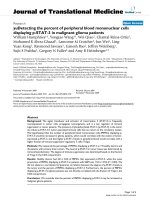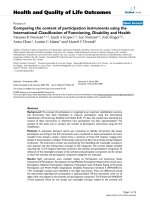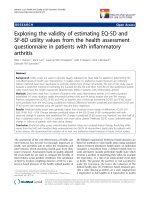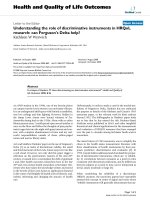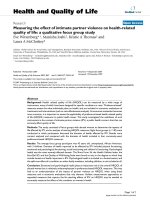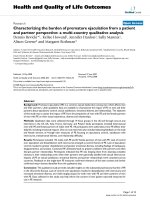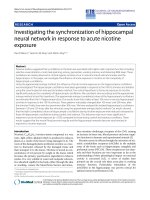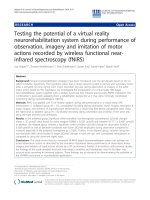báo cáo hóa học: " Analysing the causes of chronic cough: relation to diesel exhaust, ozone, nitrogen oxides, sulphur oxides and other environmental factors" pptx
Bạn đang xem bản rút gọn của tài liệu. Xem và tải ngay bản đầy đủ của tài liệu tại đây (467.63 KB, 8 trang )
BioMed Central
Page 1 of 8
(page number not for citation purposes)
Journal of Occupational Medicine
and Toxicology
Open Access
Research
Analysing the causes of chronic cough: relation to diesel exhaust,
ozone, nitrogen oxides, sulphur oxides and other environmental
factors
Beatrix Groneberg-Kloft
1
, Thomas Kraus
2
, Anke van Mark
3
, Ulrich Wagner
4
and Axel Fischer*
1
Address:
1
Division of Allergy Research, Charité – Universitätsmedizin Berlin, Free University and Humboldt-University, 13353 Berlin, Germany,
2
Institute of Occupational Medicine, University School of Medicine, RWTH Aachen, 52074 Aachen, Germany,
3
Institute of Occupational
Medicine, University Lübeck, D-23538 Lübeck, Germany and
4
Department of Medicine, Pulmonary and Critical Care Division, Philipps-
University, D-35043 Marburg, Germany
Email: Beatrix Groneberg-Kloft - ; Thomas Kraus - ; Anke
van Mark - ; Ulrich Wagner - ; Axel Fischer* -
* Corresponding author
Abstract
Air pollution remains a leading cause of many respiratory diseases including chronic cough.
Although episodes of incidental, dramatic air pollution are relatively rare, current levels of
exposure of pollutants in industrialized and developing countries such as total articles, diesel
exhaust particles and common cigarette smoke may be responsible for the development of chronic
cough both in children and adults. The present study analyses the effects of common environmental
factors as potential causes of chronic cough. Different PubMed-based researches were performed
that related the term cough to various environmental factors. There is some evidence that chronic
inhalation of diesel can lead to the development of cough. For long-term exposure to nitrogen
dioxide (NO2), children were found to exhibit increased incidences of chronic cough and
decreased lung function parameters. Although a number of studies did not show that outdoor
pollution directly causes the development of asthma, they have demonstrated that high levels
pollutants and their interaction with sunlight produce ozone (O3) and that repeated exposure to
it can lead to chronic cough. In summary, next to the well-known air pollutants which also include
particulate matter and sulphur dioxide, a number of other indoor and outdoor pollutants have been
demonstrated to cause chronic cough and therefore, environmental factors have to be taken into
account as potential initiators of both adult and pediatric chronic cough.
Introduction
Coughing and mucus secretion are coordinated neuronal
reflexes that protect the respiratory tract from noxious
exogenous substances under physiological conditions.
However, within chronic exposure to noxious substances
such as tobacco smoke, urban dust, or occupational fac-
tors [1-3], the originally protective mechanisms may lead
to a states of chronic distress with hypersecretion and
chronic coughing [4-10]. The neurophysiology of the
cough reflex and its relation to bronchoconstriction and
different forms of adult and pediatric asthma is very com-
plex [11]. However, there is little doubt that chronic
Published: 18 May 2006
Journal of Occupational Medicine and Toxicology 2006, 1:6 doi:10.1186/1745-6673-1-6
Received: 05 August 2005
Accepted: 18 May 2006
This article is available from: />© 2006 Groneberg-Kloft et al; licensee BioMed Central Ltd.
This is an Open Access article distributed under the terms of the Creative Commons Attribution License ( />),
which permits unrestricted use, distribution, and reproduction in any medium, provided the original work is properly cited.
Journal of Occupational Medicine and Toxicology 2006, 1:6 />Page 2 of 8
(page number not for citation purposes)
cough can be related to the exposure to different environ-
mental air pollutants. Amongst them, pollutants such as
diesel exhaust, ozone, nitrogen and sulphur dioxide have
all been suggested to participate as main causes or co-fac-
tors in the development of chronic cough [12].
These suggestions do not only base on epidemiological
and clinical observations, but also on the neurophysiolog-
ical and -anatomical understanding of the cough reflex. In
this respect it is generally accepted, that airway pollutant-
caused airway irritation leading to chronic cough displays
a complex phenomenon involving a variety of reflex
mechanisms [13-19].
Neurophysiologically, a subgroup of rapidly adapting
receptors (RARs) among the three major types of vagal
sensory receptors is suggested to act as "cough receptors".
Next to these RARs, a further effect by bronchopulmonary
C-fibers on the cough reflex has been suggested, and there
are data indicating that i.e. ozone, one of the main envi-
ronmental air pollutants, exerts an influence on vagal-sen-
sory innervation [20-24]. Also, transient receptor
potential vanilloid-1 seems to play a role in the mediation
of the cough reflext [25,26] and airway nerves and their
mediators in general are likely to play an important role
in the general pathology of cough and airway inflamma-
tion [27-33].
In the light of the clinical, epidemiological and experi-
mental data which point to a major role of environmental
pollutants as co-factors for the development and progres-
sion of chronic cough, the present study analysed the data
available on the association between environmental pol-
lutants and chronic cough on the basis of a large amount
of existing recent literature reviews and original articles
[12,13,34-55]. Figure 1 illustrates the deposition of some
environmental pollutants related to cough in the respira-
tory tract.
Material and methods
Methods
A PubMed research was performed using terms such as
"cough", "environmental", and various environmental
factors and publication types (date: 2006-03-03). Articles
were screened for their contents and relevant data was
analysed.
Results and discussion
Frequency of research related to cough and environmental
factors
For the terms „cough”and journal article as publication
type 23248 entries were registrated in the PubMed while
2463 review articles containing the term cough were
found (Fig. 2). To analyse specific articles related to envi-
ronmental medicine, the search was narrowed and differ-
ent terms related to environmental factors were encluded
(Fig. 3). To analyse the frequency of scientific studies
related to environmental factors and cough, different pub-
lication dates were analysed in in general, an increasing
frequency was found beginning i.e. in the year 1980 with
6 articles and increasing from 1995 with 28 articles to a
number of 65 articles in the year 2004 (Fig. 4).
Diesel exhaust
The term "diesel" was only found in a low frequency in
studies related to cough (Fig. 3). Next to health effects
caused by exposure to tobacco smoke, there has been an
increasing attention to the effects of diesel emissions in
the past years [12]. Both on the epidemiological and the
experimental field, a variety of studies demonstrated a
relation between diesel exhaust and respiratory diseases
such as chronic cough, asthma, chronic bronchitis or can-
cer. Diesel exhausts consists of a variety of components:
Next to products arising from the incomplete combustion
(carbon monoxide, nitrogen oxides, hydrocarbons
including partially oxidized forms such as ketones, alde-
hydes, phenols, and sulphur compounds), diesel exhaust
contains substances deriving from the complete air and
carbon combustion such as nitrogen, carbon dioxide and
water. In comparison to gasoline engine exhausts, diesel
emissions contain a far greater amount of nitrogen oxides
and aldehydes but less carbon monoxide. Next to these
components, diesel exhaust also includes submicron par-
ticles and fine particles below 10 μm which can cause a
variety of respiratory effects.
Chronic effects of exposure to diesel emission have been
assessed by several studies and the prevalence of chronic
cough varied from 29 to 37 % among smokers and
between 8 to 16 % in nonsmokers. The risk ratio
(observed/expected) for diesel emission exposed individ-
uals varied between 1.2 and 2.3 and there was a consistent
finding for an increased risk of chronic cough among the
studies [56-59]. In general, the non-malignant respiratory
effects of diesel exhaust exposure can be summarized as
an increased prevalence of chronic cough and also of
phlegm production and of dyspnea. Also, the FEV
1
of die-
sel exposed individuals can show a significant decrease.
However, the diesel emissions can not be incriminated as
indirect or direct causes due to confounding by other
exposures such as tobacco smoke and for the most part of
the data, no exposure-response relationships are present.
Nitrogen dioxide
Nitrogen dioxide (NO2) is an oxidizing free radical which
can initiate a number of destructive pathways in the
human body [12,60]. NO2 plays an important role in
atmospheric pollution and might be a major cause of
human respiratory problems such as chronic cough in
Journal of Occupational Medicine and Toxicology 2006, 1:6 />Page 3 of 8
(page number not for citation purposes)
urban areas [61]. Numerous studies have addressed a rela-
tionship between NO2 and chronic cough (Fig. 3).
In 1985, primary schoolchildren and their mothers were
surveyed in Hong Kong to study the possible relationship
of nitrogen dioxide (NO2)-related environmental air pol-
lution to respiratory illnesses [62]. Using personal sam-
plers to measure NO2, the study also assessed the major
sources of NO2 in the indoor environment and examined
if an increased NO2 concentration is positively associated
with respiratory symptoms. The levels of NO2 among the
examined 319 mothers were increased by 21% if there was
dust exposure found at the mothers' workplace. There was
an increase of 18% if they used cooking fuels such as ker-
osene or liquid petroleum, and an increase of 11% when
the kitchens did not have a ventilation system. For chronic
cough, an increase in NO2 levels of 18% was found
among those with chronic cough. The levels of NO2
among the examined 362 children were correlated with
NO2 levels measured in their classrooms, all of which had
opened windows so that the NO2 came from outdoors
[62].
The effect of indoor nitrogen dioxide exposure on the inci-
dence of respiratory symptoms and pulmonary function
level was also examined in an American cohort of 1,567
Caucasian children aged between seven and eleven years
and examined from 1983 through 1988 [63]. Nitrogen
dioxide was assessed three indoor locations over 2 consec-
utive weeks in the winter and summer periods and house-
hold annual averages of the nitrogen dioxide
concentrations were assessed as continuous variables and
as four categories. Multiple logistic regression analysis of
symptom reports after indoor monitoring then revealed
that an increased cumulative incidence of lower respira-
tory symptoms was positively associated with a 15-ppb
Deposition of environmental polluatants in the respiratory tractFigure 1
Deposition of environmental polluatants in the respiratory tract. (modified from [11]).
Journal of Occupational Medicine and Toxicology 2006, 1:6 />Page 4 of 8
(page number not for citation purposes)
increase in the household annual nitrogen dioxide mean
(odds ratio (OR) = 1.4, 95% confidence interval (95% Cl)
1.1 to 1.7). The response variable indicated the report of
one or more of the following symptoms: chronic cough,
chronic phlegm, attacks of shortness of breath with
wheeze, chronic wheeze, or bronchitis. School girls
showed a stronger association than boys (OR = 1.7, 95%
Cl 1.3–2.2 vs. OR = 1.2, 95% Cl 0.9–1.5). An analysis of
pulmonary function measurements showed no consistent
effect of nitrogen dioxide. These results were consistent
with earlier reports based on categorical indicators of
household nitrogen dioxide sources and provided a spe-
cific association of respiratory diseases such as chronic
cough with nitrogen dioxide as measured in children's
homes [63].
Also, the SAPALDIA study examined the association
between NO2 and chronic cough and it was reported that
an increase of 10 μg/m
3
in pollutant levels was associated
with an increase in the prevalence of chronic cough [64].
Next to this study, the Swiss Study on Childhood Allergy
and Respiratory Symptoms with Respect to Air Pollution,
Climate and Pollen (SCARPOL-study) [65] also reported
that the symptom rate of chronic cough, adjusted for indi-
vidual risk factors, was positively associated with NO2
[65].
Together, these data indicate that long-term NO2 expo-
sure leads to increased incidences of chronic cough and
decreased lung function. Also, weak associations between
short-term NO2 exposure and respiratory symptoms and
a decrement in lung function parameters were found in
children, but not consistently in exposed women.
PubMed search for the terms "cough" and different environmental factorsFigure 3
PubMed search for the terms "cough" and different environmental factors.
PubMed search for the terms "cough" and publication typesFigure 2
PubMed search for the terms "cough" and publication types.
Journal of Occupational Medicine and Toxicology 2006, 1:6 />Page 5 of 8
(page number not for citation purposes)
Sulphur dioxide
With regard to one of the most dramatical urban environ-
mental exposures to air pollutants, the London smogs
[66-70], sulphur dioxide (SO2) is known as major respi-
ratory irritant since many years. Next to its acute effects,
SO2 may also be related to the incidence of chronic cough
[12]. In total, 149 PubMed entries inclided the terms
"cough" and "sulphur" (Fig. 3). Some of them, but others
not, found associations between SO2 exposure and respi-
ratory symptoms such as chronic cough and daily mortal-
ity and morbidity. In general, single-pollutant
correlations sometimes disappeared when other pollut-
ants such as suspended particulate matter (SPM) were
included.
A study on indoor air pollution and respiratory health in
urban and rural China revealed interesting relations
between chronic cough and SO2 [71]: During the summer
of 1999, data on the respiratory health outcomes and rel-
evant covariates was collected from 3,709 Chinese adult
individuals in the cities of Beijing, Anqing City, and in
rural communities. Indoor SO2 was measured in a ran-
dom sample of selected households and using logistic
regression and controlling for important covariates
(excluding PM10 and SO2) and familial intraclass corre-
lation, highly significant differences were found between
study areas in the prevalence of chronic cough. In general,
the lowest prevalence of respiratory symptoms was
observed in Anqing City, a higher prevalence in rural
Anqing, and the highest prevalence in Beijing. However,
median indoor concentrations of SO2 were similar in all
three areas (Beijing: 14 microg/m3, Anqing City: 25
microg/m3, rural Anqing: 20 microg/m3) [71].
A further study in Canada also addressed the association
of inhalable sulfates, SO2 and childhood chronic cough
[72]: Preadolescent school children, aged 7–11 years, who
resided in 10 rural Canadian communities areas of mod-
erate and low exposure to regional sulfate and ozone pol-
lution were examined. The communities were situated in
central Saskatchewan, a low-exposure region, and in
southwestern Ontario, an area with moderately increased
SO2 exposures resulting from a long-distance atmos-
pheric transport of polluted air masses. In this cross-sec-
tional study, the annual mean and 90th percentile
concentrations of inhalable sulfates were three times
higher in Ontario than in Saskatchewan but levels of SO2
were low in both regions. After controlling for the effects
of age, sex, parental smoking, parental education, and gas
cooking, no significant regional differences were observed
in rates of chronic cough [72]. In the SAPALDIA study,
there were no data on the association between SO2 and
chronic cough reported [64]. However, other European
studies found an association between SO2 exposure and
chronic cough [73].
Ozone
Ozone is a very powerful oxidant and also a very toxic air
pollutant [12,74]. As a gaseous air pollutant, its primary
target organ is the respiratory tract [75] and exposure to
even slightly elevated concentrations of ozone leads to a
range of respiratory symptoms including chronic cough
[76-78].
A variety of studies focused on the relation between
ozone-exposure and chronic cough (Fig. 3) and revealed
controversial results. For instance, the effects of ambient
ozone (O3) on respiratory function and acute respiratory
symptoms were assessed 7- to 9-yr-old schoolchildren fol-
lowed longitudinally at 1- to 2-wk intervals over a period
of 6 months at three schools in Mexico City. The maxi-
mum O3 level which was measured exceeded the World
Health Organization guideline of 80 ppb and the U.S.
standard of 120 ppb in every week. For an increase from
lowest to highest in the mean O3 level during the 48 hr
before spirometry (53 ppb), logistic regression estimated
relative odds of 1.7 for a child reporting cough on the day
of spirometry [79].
In the cross-sectional study in Canada with preadolescent
school children, aged 7–11 years, in the low-exposure
region central Saskatchewan, and in the moderately pol-
luted area in southwestern Ontario, no significant
regional differences were observed in rates of chronic
cough. Here, the annual mean of the 1-hr daily maxima of
ozone was higher in Ontario (46.3 ppb) than in Saskatch-
ewan (34.1 ppb), with 90th percentile concentrations of
80 ppb in Ontario and 47 ppb in Saskatchewan and sum-
Frequency of studies related to cough and environmental fac-tors as assessed by a PubMed search for the terms "cough" and "environmental" and different publication datesFigure 4
Frequency of studies related to cough and environmental fac-
tors as assessed by a PubMed search for the terms "cough"
and "environmental" and different publication dates.
Journal of Occupational Medicine and Toxicology 2006, 1:6 />Page 6 of 8
(page number not for citation purposes)
mertime 1-hr daily maxima means were 69.0 ppb in
Ontario and 36.1 ppb in Saskatchewan [72].
In the Swiss SAPALDIA and SCARPOL studies, no associ-
ations between ozone and chronic cough were found
[64,65].
In contrast to these epidemiological data, there is a large
body of experimental evidence that ozone influences pul-
monary vagal-sensory nerve fibers which are suggested to
be major mediators of the cough reflex [24,80]. However,
these effects may be reflected by the known short-term
acute effects of ozone such as pulmonary function decre-
ments, increased airway responsiveness and airway
inflammation.
In this respect, exposure-response relations are non-linear
for the respective associations between O3 and FEV1,
inflammatory changes, and changes in hospital admis-
sions, whereas it has been reported that the relation
between percent change in symptom exacerbation among
adults and asthmatics is linear. Also, the single-pollutant
associations between ozone exposure and hospital admis-
sions for respiratory diseases and daily mortality were
shown to be statistically significant, even in multi-pollut-
ant models.
Other environmental causes
There is also a variety of other environmental factors
which have been reported to contribute to the prevalence
of chronic cough. In this respect, recent reports have dem-
onstrated a relation between allergen such as Humicola
fuscoatra in indoor air and chronic cough (combined with
sputum eosinophilia) [81] or arsenic contaminated well
water in Bangladesh [82]. Here, a prevalence comparison
study of chronic cough and chronic bronchitis among
subjects with or without arsenic exposure revealed a crude
prevalence ratio for chronic cough and chronic bronchitis
amounted to 2.1 (95% CI 0.7–6.1). The prevalence ratios
for chronic cough increased with increasing exposure, i.e.,
1.0, 1.6, 2.7 and 2.6 for the exposure categories using
unexposed as the reference, indicating that long-term
ingestion of arsenic exposure can cause chronic cough
[82].
Also, depleted uranium, which is a radioactive heavy
metal that is commonly used in missiles, has been shown
to be associated with chronic cough as a health risk [83].
Next to microbially-related chronic cough [84], a further
environmental cause may be found in exposure to For-
maldehyde: [85]. A study on the relation of chronic respi-
ratory symptoms and pulmonary function to indoor
formaldehyde (HCHO) examined in a sample of 298 chil-
dren (6–15 years of age) and 613 adults revealed an asso-
ciation to chronic cough.
Conclusion
Environmental air pollution is not only one of the causes
that might lead to severe diseases such as cancer or cardi-
orespiratory disease, but also associated with the preva-
lence of chronic cough both in adults and children.
Although episodes of incidental, dramatic air pollution
are relatively rare, the currently found levels of exposure to
pollutants especially in developing countries may increase
the prevalence of chronic cough. Next to well-known air
pollutants such as nitrogen dioxide, a number of other
indoor and outdoor pollutants have recently been dem-
onstrated to cause chronic cough and therefore, environ-
mental factors have to be taken into account as potential
initiators of both adult and pediatric chronic cough.
Declaration of competing interests
The author(s) declare that they have no competing inter-
ests.
Authors' contributions
BGK and AF have planed the study. BGK has peformed the
data analysis and interpretation and drafted the article.
TK, AVM and UW have all been involved in interpreting
and discussing the data and revising the article critically
for important intellectual content.
References
1. Yelin E, Katz P, Balmes J, Trupin L, Earnest G, Eisner M, Blanc P:
Work Life of Persons with Asthma, Rhinitis, and COPD: A
Study Using a National, Population-Based Sample. J Occup
Med Toxicol 2005, 1:2.
2. Groneberg DA, Fischer A: Occupational Medicine and Toxicol-
ogy. J Occup Med Toxicol 2005, 1:1.
3. Groneberg DA, Nowak D, Wussow A, Fischer A: Chronic cough
due to occupational factors. J Occup Med Toxicol 2005, 1:3.
4. Groneberg DA, Wagner U, Chung KF: Mucus and fatal asthma.
Am J Med 2004, 116:66-67.
5. Chung KF, Groneberg DA: Effects of cigarette smoke on pulmo-
nary homeostasis. Am J Respir Cell Mol Biol 2005, 32:167.
6. Chung KF, Caramori G, Groneberg DA: Airway obstruction in
chronic obstructive pulmonary disease. N Engl J Med 2004,
351:1459-1461.
7. Groneberg DA, Eynott PR, Lim S, Oates T, Wu R, Carlstedt I, Rob-
erts P, McCann B, Nicholson AG, Harrison BD, Chung KF: Expres-
sion of respiratory mucins in fatal status asthmaticus and
mild asthma. Histopathology 2002, 40:367-373.
8. Groneberg DA, Eynott PR, Oates T, Lim S, Wu R, Carlstedt I, Nichol-
son AG, Chung KF: Expression of MUC5AC and MUC5B
mucins in normal and cystic fibrosis lung. Respir Med 2002,
96:81-86.
9. Springer J, Groneberg DA, Pregla R, Fischer A: Inflammatory cells
as source of tachykinin-induced mucus secretion in chronic
bronchitis. Regul Pept 2005, 124:195-201.
10. Groneberg DA, Peiser C, Dinh QT, Matthias J, Eynott PR, Heppt W,
Carlstedt I, Witt C, Fischer A, Chung KF: Distribution of respira-
tory mucin proteins in human nasal mucosa. Laryngoscope
2003, 113:520-524.
11. Nowak D: Chemosensory irritation and the lung. Int Arch Occup
Environ Health 2002, 75:326-331.
12. Balmes J, Becklake M, Blanc P, Henneberger P, Kreiss K, Mapp C, Mil-
ton D, Schwartz D, Toren K, Viegi G: American Thoracic Society
Journal of Occupational Medicine and Toxicology 2006, 1:6 />Page 7 of 8
(page number not for citation purposes)
Statement: Occupational contribution to the burden of air-
way disease. Am J Respir Crit Care Med 2003, 167:787-797.
13. Chung KF, Widdicombe J: Acute and chronic cough. Pulm Phar-
macol Ther 2004, 17:471-473.
14. Carr MJ: Plasticity of vagal afferent fibres mediating cough.
Pulm Pharmacol Ther 2004, 17:447-451.
15. Mazzone SB: Sensory regulation of the cough reflex. Pulm Phar-
macol Ther 2004, 17:361-368.
16. Canning BJ, Mazzone SB, Meeker SN, Mori N, Reynolds SM, Undem
BJ: Identification of the tracheal and laryngeal afferent neu-
rones mediating cough in anaesthetized guinea-pigs. J Physiol
2004, 557:543-558.
17. Belvisi MG: Airway sensory innervation as a target for novel
therapies: an outdated concept? Curr Opin Pharmacol 2003,
3:239-243.
18. Widdicombe JG: Overview of neural pathways in allergy and
asthma. Pulm Pharmacol Ther 2003, 16:23-30.
19. Belvisi MG: Sensory nerves and airway inflammation: role of A
delta and C-fibres. Pulm Pharmacol Ther 2003, 16:1-7.
20. Adcock JJ, Douglas GJ, Garabette M, Gascoigne M, Beatch G, Walker
M, Page CP: RSD931, a novel anti-tussive agent acting on air-
way sensory nerves. Br J Pharmacol 2003, 138:407-416.
21. Undem BJ, Carr MJ, Kollarik M: Physiology and plasticity of puta-
tive cough fibres in the Guinea pig. Pulm Pharmacol Ther 2002,
15:193-198.
22. Canning BJ: Interactions between vagal afferent nerve sub-
types mediating cough. Pulm Pharmacol Ther 2002, 15:187-192.
23. Eccles R, Lee PC: Cough induced by airway vibration as a
model of airway hyperreactivity in patients with acute upper
respiratory tract infection. Pulm Pharmacol Ther 2004,
17:337-342.
24. Lee LY, Kwong K, Lin YS, Gu Q: Hypersensitivity of bronchopul-
monary C-fibers induced by airway mucosal inflammation:
cellular mechanisms. Pulm Pharmacol Ther 2002, 15:199-204.
25. Trevisani M, Gazzieri D, Benvenuti F, Campi B, Dinh QT, Groneberg
DA, Rigoni M, Emonds-Alt X, Creminon C, Fischer A, Geppetti P,
Harrison S: Ethanol Causes Inflammation in the Airways by a
Neurogenic and TRPV1-Dependent Mechanism. J Pharmacol
Exp Ther 2004.
26. Groneberg DA, Niimi A, Dinh QT, Cosio B, Hew M, Fischer A, Chung
KF: Increased expression of transient receptor potential
vanilloid-1 in airway nerves of chronic cough. Am J Respir Crit
Care Med 2004, 170:1276-1280.
27. Groneberg DA, Chung KF: Models of chronic obstructive pul-
monary disease. Respir Res 2004, 5:18.
28. Thai Dinh Q, Groneberg DA, Peiser C, Joachim RA, Frossard N, Arck
PC, Klapp BF, Fischer A: Expression of substance P and nitric
oxide synthase in vagal sensory neurons innervating the
mouse airways. Regul Pept 2005, 126:189-194.
29. Groneberg DA, Heppt W, Cryer A, Wussow A, Peiser C, Zweng M,
Dinh QT, Witt C, Fischer A: Toxic rhinitis-induced changes of
human nasal mucosa innervation. Toxicol Pathol 2003,
31:326-331.
30. Groneberg DA, Heppt W, Welker P, Peiser C, Dinh QT, Cryer A,
Zweng M, Witt C, Fischer A: Aspirin-sensitive rhinitis associated
changes in upper airway innervation. Eur Respir J 2003,
22:986-991.
31. Groneberg DA, Quarcoo D, Frossard N, Fischer A: Neurogenic
mechanisms in bronchial inflammatory diseases. Allergy 2004,
59:1139-1152.
32. Heppt W, Peiser C, Cryer A, Dinh QT, Zweng M, Witt C, Fischer A,
Groneberg DA: Innervation of human nasal mucosa in envi-
ronmentally triggered hyperreflectoric rhinitis. J Occup Envi-
ron Med 2002, 44:924-929.
33. Heppt W, Thai Dinh Q, Cryer A, Zweng M, Noga O, Peiser C, Melvan
M, Witt C, Fischer A, Groneberg DA: Phenotypic alteration of
neuropeptide-containing nerve fibres in seasonal intermit-
tent allergic rhinitis. Clin Exp Allergy 2004, 34:1105-1110.
34. Belvisi MG, Geppetti P: Cough. 7: Current and future drugs for
the treatment of chronic cough. Thorax 2004, 59:438-440.
35. de Jongste JC, Shields MD: Cough . 2: Chronic cough in children.
Thorax 2003, 58:998-1003.
36. Dicpinigaitis PV: Cough. 4: Cough in asthma and eosinophilic
bronchitis. Thorax 2004, 59:71-72.
37. Fontana GA, Pistolesi M: Cough. 3: chronic cough and gastro-
oesophageal reflux. Thorax 2003, 58:1092-1095.
38. McGarvey LP: Cough . 6: Which investigations are most useful
in the diagnosis of chronic cough? Thorax 2004, 59:342-346.
39. Morice AH, Kastelik JA: Cough. 1: Chronic cough in adults. Tho-
rax 2003, 58:901-907.
40. Morice AH, Geppetti P: Cough. 5: The type 1 vanilloid receptor:
a sensory receptor for cough. Thorax 2004, 59:257-258.
41. Ahmedzai SH: Cough in cancer patients. Pulm Pharmacol Ther
2004, 17:415-423.
42. Chung KF, Widdicombe JG: Cough as a symptom. Pulm Pharmacol
Ther 2004, 17:329-332.
43. Chung KF, Chang AB: Therapy for cough: active agents. Pulm
Pharmacol Ther 2002, 15:335-338.
44. Dicpinigaitis PV: Potential new cough therapies. Pulm Pharmacol
Ther 2004, 17:459-462.
45. Fong J, Sandhu G, Ellaway P, Davey N, Strutton P, Murphy K, Guz A:
What do we know about how humans cough? Pulm Pharmacol
Ther 2004, 17:431-434.
46. Fontana GA, Lavorini F, Geri P, Zanasi A, Piumelli R: Cough in chil-
dren with congenital central hypoventilation syndrome. Pulm
Pharmacol Ther 2004, 17:425-429.
47. Harrison NK: Idiopathic pulmonary fibrosis: a nervous cough?
Pulm Pharmacol Ther 2004, 17:347-350.
48. Ing AJ: Cough and gastro-oesophageal reflux disease. Pulm
Pharmacol Ther 2004, 17:403-413.
49. McGarvey LP, Ing AJ: Idiopathic cough, prevalence and underly-
ing mechanisms. Pulm Pharmacol Ther 2004, 17:435-439.
50. Morice AH: Post-nasal drip syndrome a symptom to be
sniffed at? Pulm Pharmacol Ther 2004, 17:343-345.
51. Niimi A, Chung KF: Airway inflammation and remodelling
changes in patients with chronic cough: do they tell us about
the cause of cough? Pulm Pharmacol Ther 2004, 17:441-446.
52. Page C, Reynolds SM, Mackenzie AJ, Geppetti P: Mechanisms of
acute cough. Pulm Pharmacol Ther 2004, 17:389-391.
53. Pavord ID: Cough and asthma. Pulm Pharmacol Ther 2004,
17:399-402.
54. Smith JA, Calverley PM: Cough in chronic obstructive pulmo-
nary disease. Pulm Pharmacol Ther 2004, 17:393-398.
55. Morgan WK, Reger RB, Tucker DM: Health effects of diesel emis-
sions. Ann Occup Hyg 1997, 41:643-658.
56. Gamble J, Jones W, Hudak J: An epidemiological study of salt
miners in diesel and nondiesel mines. Am J Ind Med 1983,
4:435-458.
57. Gamble JF, Jones WG: Respiratory effects of diesel exhaust in
salt miners. Am Rev Respir Dis 1983, 128:389-394.
58. Attfield MD, Trabant GD, Wheeler RW: Exposure to diesel fumes
and dust at six potash mines. Ann Occup Hyg 1982, 26:817-831.
59. Kirsch M, Korth HG, Sustmann R, de Groot H: The pathobio-
chemistry of nitrogen dioxide. Biol Chem
2002, 383:389-399.
60. Sauerbeck G, Parkin CS, Houston S, Whall C, Newton A, Carlyle J:
Nitrogen dioxide and particle pollution near trunk roads and
in towns of the south Midlands in England. J R Soc Health 2000,
120:183-187.
61. Koo LC, Ho JH, Ho CY, Matsuki H, Shimizu H, Mori T, Tominaga S:
Personal exposure to nitrogen dioxide and its association
with respiratory illness in Hong Kong. Am Rev Respir Dis 1990,
141:1119-1126.
62. Neas LM, Dockery DW, Ware JH, Spengler JD, Speizer FE, Ferris BGJ:
Association of indoor nitrogen dioxide with respiratory
symptoms and pulmonary function in children. Am J Epidemiol
1991, 134:204-219.
63. Zemp E, Elsasser S, Schindler C, Kunzli N, Perruchoud AP,
Domenighetti G, Medici T, Ackermann-Liebrich U, Leuenberger P,
Monn C, Bolognini G, Bongard JP, Brandli O, Karrer W, Keller R,
Schoni MH, Tschopp JM, Villiger B, Zellweger JP: Long-term ambi-
ent air pollution and respiratory symptoms in adults (SAPA-
LDIA study). The SAPALDIA Team. Am J Respir Crit Care Med
1999, 159:1257-1266.
64. Braun-Fahrlander C, Vuille JC, Sennhauser FH, Neu U, Kunzle T,
Grize L, Gassner M, Minder C, Schindler C, Varonier HS, Wuthrich
B: Respiratory health and long-term exposure to air pollut-
ants in Swiss schoolchildren. SCARPOL Team. Swiss Study
on Childhood Allergy and Respiratory Symptoms with
Respect to Air Pollution, Climate and Pollen. Am J Respir Crit
Care Med 1997, 155:1042-1049.
65. Stone R: Air pollution. Counting the cost of London's killer
smog. Science 2002, 298:2106-2107.
Publish with BioMed Central and every
scientist can read your work free of charge
"BioMed Central will be the most significant development for
disseminating the results of biomedical research in our lifetime."
Sir Paul Nurse, Cancer Research UK
Your research papers will be:
available free of charge to the entire biomedical community
peer reviewed and published immediately upon acceptance
cited in PubMed and archived on PubMed Central
yours — you keep the copyright
Submit your manuscript here:
/>BioMedcentral
Journal of Occupational Medicine and Toxicology 2006, 1:6 />Page 8 of 8
(page number not for citation purposes)
66. Bell ML, Davis DL: Reassessment of the lethal London fog of
1952: novel indicators of acute and chronic consequences of
acute exposure to air pollution. Environ Health Perspect 2001,
109 Suppl 3:389-394.
67. Masood E: Once upon a smoggy day in London town. Nature
1996, 381:181.
68. Thurston GD, Ito K, Lippmann M, Hayes C: Reexamination of
London, England, mortality in relation to exposure to acidic
aerosols during 1963-1972 winters. Environ Health Perspect 1989,
79:73-82.
69. Ito K, Thurston GD: Characterization and reconstruction of
historical London, England, acidic aerosol concentrations.
Environ Health Perspect 1989, 79:35-42.
70. Venners SA, Wang B, Ni J, Jin Y, Yang J, Fang Z, Xu X: Indoor air
pollution and respiratory health in urban and rural China. Int
J Occup Environ Health 2001, 7:173-181.
71. Stern BR, Raizenne ME, Burnett RT, Jones L, Kearney J, Franklin CA:
Air pollution and childhood respiratory health: exposure to
sulfate and ozone in 10 Canadian rural communities. Environ
Res 1994, 66:125-142.
72. Forsberg B, Stjernberg N, Wall S: Prevalence of respiratory and
hyperreactivity symptoms in relation to levels of criteria air
pollutants in Sweden. Eur J Public Health 1997, 7/3:291-296.
73. Bhalla DK: Ozone-induced lung inflammation and mucosal
barrier disruption: toxicology, mechanisms, and implica-
tions. J Toxicol Environ Health B Crit Rev 1999, 2:31-86.
74. Mudway IS, Kelly FJ: Ozone and the lung: a sensitive issue. Mol
Aspects Med 2000, 21:1-48.
75. Brunekreef B, Holgate ST: Air pollution and health. Lancet 2002,
360:1233-1242.
76. Mathieu-Nolf M: Poisons in the air: a cause of chronic disease
in children. J Toxicol Clin Toxicol
2002, 40:483-491.
77. Oberdorster G: Pulmonary effects of inhaled ultrafine parti-
cles. Int Arch Occup Environ Health 2001, 74:1-8.
78. Castillejos M, Gold DR, Dockery D, Tosteson T, Baum T, Speizer FE:
Effects of ambient ozone on respiratory function and symp-
toms in Mexico City schoolchildren. Am Rev Respir Dis 1992,
145:276-282.
79. Irwin RS, Madison JM, Fraire AE: The cough reflex and its relation
to gastroesophageal reflux. Am J Med 2000, 108 Suppl
4a:73S-78S.
80. Ogawa H, Fujimura M, Tofuku Y: Isolated chronic cough with
sputum eosinophilia caused by Humicola fuscoatra antigen:
the importance of environmental survey for fungus as an eti-
ologic agent. J Asthma 2002, 39:331-336.
81. Milton AH, Rahman M: Respiratory effects and arsenic contam-
inated well water in Bangladesh. Int J Environ Health Res 2002,
12:175-179.
82. Abu-Qare AW, Abou-Donia MB: Depleted uranium the grow-
ing concern. J Appl Toxicol 2002, 22:149-152.
83. Baboolal S, Rawlins SC: Seroprevalence of toxocariasis in
schoolchildren in Trinidad. Trans R Soc Trop Med Hyg 2002,
96:139-143.
84. Krzyzanowski M, Quackenboss JJ, Lebowitz MD: Chronic respira-
tory effects of indoor formaldehyde exposure. Environ Res
1990, 52:117-125.
